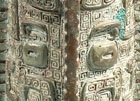J.J. Lally & Co., Oriental Art / New York City, New York
MenuPast Exhibition
The Gordon Collection:
Chinese Ceramics and Works of Art
March 12 - April 4, 2009
65.
AN ARCHAIC BRONZE RITUAL WINE VESSEL (GU)
Shang Dynasty, Anyang Phase, 12th-11th Century B.C.
of slender flaring beaker form with four elongated blades on the trumpet neck, each cast with a dissolved taotie mask above a narrow band of four stylized serpents with angular scroll-bodies, the designs all in varied relief amidst finely drawn leiwen grounds and with similar densely patterned angular scrollwork on all of the raised decoration except the protruding oval eyes, the central knop decorated with two taotie masks centered on and divided by notched flanges, above a plain recessed band with impressed cruciform motifs interrupted by two raised line collars, the spreading foot decorated to match the central knop, with two large taotie masks and notched flanges, below a narrow frieze of kui dragons, standing on a plain ring foot, with an attractive green patina showing a few areas of reddish cuprite and some areas of malachite green encrustation widely scattered over the surface.
Height 12 1⁄2 inches (31.8 cm)
Shang dynasty gu of this classic form with very similar decoration are well known from the excavations of the Shang capital at Anyang, and comparable examples are recorded in important museum and private collections: a gu of this type in Minneapolis Institute of Arts is illustrated by Karlgren in A Catalogue of the Chinese Bronzes in the Alfred F. Pillsbury Collection, Minneapolis, 1952, no. 25, pp. 74-75; one from the Morse Collection was exhibited on loan at the Metropolitan Museum of Art and illustrated in the 1982 exhibition catalogue, Spirit and Ritual, no. 8 and frontispiece; another example in the Museum of Fine Arts, Boston, is illustrated by Jan Fontein and Tung Wu in Unearthing China’s Past, Boston, 1973, no. 8, p. 38; the gu from the Sackler Collection now in Washington D.C. is illustrated by Bagley, Shang Ritual Bronzes in the Arthur M. Sackler Collections, Washington D.C., 1987, no. 36, pp. 248-250; a similar vessel in the Art Institute of Chicago is illustrated by Kelley and Ch’en in Chinese Bronzes from the Buckingham Collection, Chicago, 1946, pp. 32-33; and another example from the J. Lionberger Davis Collection is illustrated by Owyoung in Ancient Chinese Bronzes in the St. Louis Art Museum, no. 8, pp. 58-59. Compare also the example from the Gross-Spuhler Collection which was exhibited on loan at the Rietberg Museum, Zurich, and illustrated by Brinker in the catalogue entitled Bronzen aus dem alten China, Zurich, 1975, no. 40, p. 81.
A similar bronze gu excavated at Xiaqiyuan, Ci county, Hebei province, is illustrated in Wenwu, 1974, no. 11, fig. 2, p. 91.
商 安陽時期 青銅觚 高 31.8 厘米
